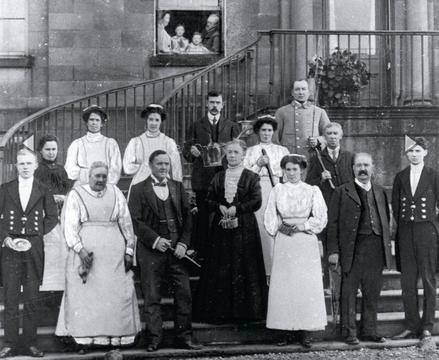
Here at Erddig near the market town of Wrexham (pictured below left), the serving staff photographed in 1912 included gardeners, housemaids, footmen, butler, cook, laundress, housekeeper and the estate foreman.National Trust / Public Library
How shall we ever know if it’s morning if there’s no servant to pull up the blind?
—J.M. Barrie
Visitors to Britain’s great country mansions often imagine the magical lives lived within their walls, fantasy taking flight at the thought of evening soirées in sumptuous drawing rooms, of delicious meals served on elegant china, luscious wines filling the rows of crystal glasses at each place. Touring the gorgeous bedrooms suggests the delights of breakfasting among the pillows of a four-poster and the pleasures of preening with the myriad mysterious implements of a Victorian toilet set. Who would not think that life in these great houses was really rather heavenly?
Indeed, when the sixth Marquess of Bath recalled his boyhood at Longleat, where he was born in 1905, he said, “You were looked after in the lap of luxury.” Even as a child, he had his own valet—one of the 43 indoor servants. “I think the more servants you had the better,” he commented. Other aristocrats evidently agreed. In 1827, the Earl of Lichfield employed 107 servants at Shugborough Hall near Stafford. Tatton Park, Baron Egerton’s home in Knutsford, Cheshire, had some 40 indoor servants in the 1890s, while at Eaton Hall near Chester, the Duke of Westminster employed 300 indoor and outdoor servants, among them more than 40 gardeners.
These large staffs meant that the majority of the residents of stately homes were not the wealthy owners, but servants, and servants, life was hard and certainly far from heavenly. Their multitudinous tasks included keeping the house and grounds immaculate, caring for horses and carriages, cooking and serving meals, raising children, sewing, washing, and providing creature comforts including coal for the fireplaces, water in the bedrooms, and food and drink whenever it was required. At Welbeck Abbey, the fifth Duke of Portland insisted on having roast chicken whenever he fancied a slice, so one of his 38 kitchen servants had to ensure that the spit always had one just ready for his delectation.
To provide such levels of service, regimentation was necessary. The butler, or the house steward, supervised the male servants such as the footmen and valets, while the housekeeper supervised the maids. Under her, the cook was in charge of a brigade of kitchen maids, scullery maids, and stillroom maids. A nanny or nurse looked after the children with one or more nurserymaids to help. The head parlormaid oversaw all the service in the family’s rooms, while the head housemaid had a bevy of under-housemaids to dust, clean and polish. Outside, the coachman oversaw grooms and stable boys, while the head gardener would assign some gardeners to the greenhouses, with others working on flower beds, in the kitchen garden, and in the shrubbery.
Occasionally, upper servants such as governesses, ladies’ maids, and housekeepers might come from an impoverished family of gentlefolk. In Jane Eyre, for example, the housekeeper, Mrs. Fairfax, was distantly related to her employer, Mr. Rochester, and both Charlotte and Anne Brontë, daughters of a clergyman, had to make their living as governesses. As Anne Brontë made clear in her novel Agnes Grey, their position could be uncomfortable. Wanting to preserve their social status, they set themselves apart from lowlier servants, condemning themselves to loneliness and sometimes resentment. Even among servants from working-class backgrounds, servants higher up the hierarchy guarded their prestige jealously. Young servants on the bottom rung of the ladder could be bossed by everyone—except their employers. Junior servants would rarely if ever see their masters and mistresses.
Indeed, keeping out of sight was often an order. The third Lord Crewe decreed that “No housemaids were ever to be seen in Crewe Hall except in Chapel.” Similarly, the 10th Duke of Bedford insisted that at Woburn Abbey no female servants be seen after midday on pain of dismissal.
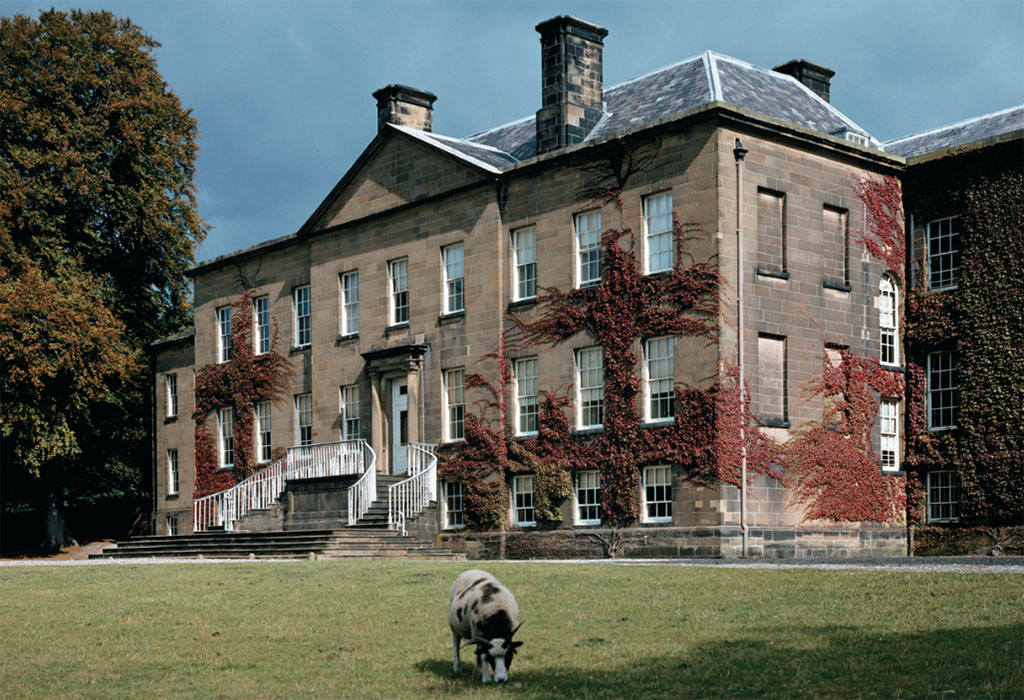
AKG-IMAGES/A.F. KERSTING
Such rules meant that housemaids had to get up as early as 5:30 a.m. in order to clean the living areas and light fires before the family and guests appeared. In the kitchens, other maids would be lighting stoves and boiling gallons of water, which had to be carried upstairs by senior maids and valets to fill the china washbasins or hip baths in every bedroom.
Read more
Servants had to use the back stairs and side entrances so that they wouldn’t inadvertently come across the people to whom they ministered. Some houses even had separate corridors for the servants’use. Servants’ accommodation was also hidden. At the back of Tatton Hall—the side that visitors would never have seen—is a brick wing off the kitchen for the maids. Attics were also used for maids’ rooms. They were cold in winter and hot in summer. Male staff often slept near their work. At Shugborough visitors can see the remote brick bothies where gardeners slept so they could get up on cold nights to make sure all was well with the heating in the greenhouses. Grooms and stable boys lived over the stables; footmen sometimes bedded down near valuables such as silver closets.
Servants typically ate dinner at around 2 p.m. in the servants’ hall. Everyone waited behind their chairs until the butler and housekeeper arrived and signaled they could sit. The butler generally served the meat, while the housekeeper filled plates with vegetables and handed them out in order of seniority so the youngest received theirs last. For dessert, the senior servants retired to the housekeeper’s or butler’s parlor, where they would be waited on by one of the maids, leaving the younger servants free to chat. This pause in the day’s toil provided some free time, but servants were rarely allowed to leave the house. A bell could ring at any time, calling them to provide a service or to perform routine tasks. In effect, there was no end to their working day, and one day off a month was the most they could hope for.
Maids typically made their own uniforms, sometimes from cloth provided by their employers: typically pink or blue cotton dresses for housework, with parlormaids changing to black, with white aprons and caps, in the afternoon. At Tatton Hall, even aprons were color-coded, with black trim for small girls, green trim for big girls, red for small boys, blue for big boys and so on. In the 18th century, many male servants wore elaborate liveries provided by their employers, but by the end of the 19th century typically only coachmen (and later chauffeurs) wore them.
The contrast between the free clothes that some male servants were given and the hand-made dresses that maids had to supply themselves is only one way in which women servants generally had a tougher deal than men. While housekeepers and butlers had comparable responsibilities, butlers were paid much more. In the 1870s the butler at Shugborough earned £73 a year, while the housekeeper got only £42. A valet earned £52 while a lady’s maid doing similar work got only £25. In the lower ranks, a laundry maid earned £18, while a nursery maid earned 9 guineas, though her boss, the head nurse, was paid £31.
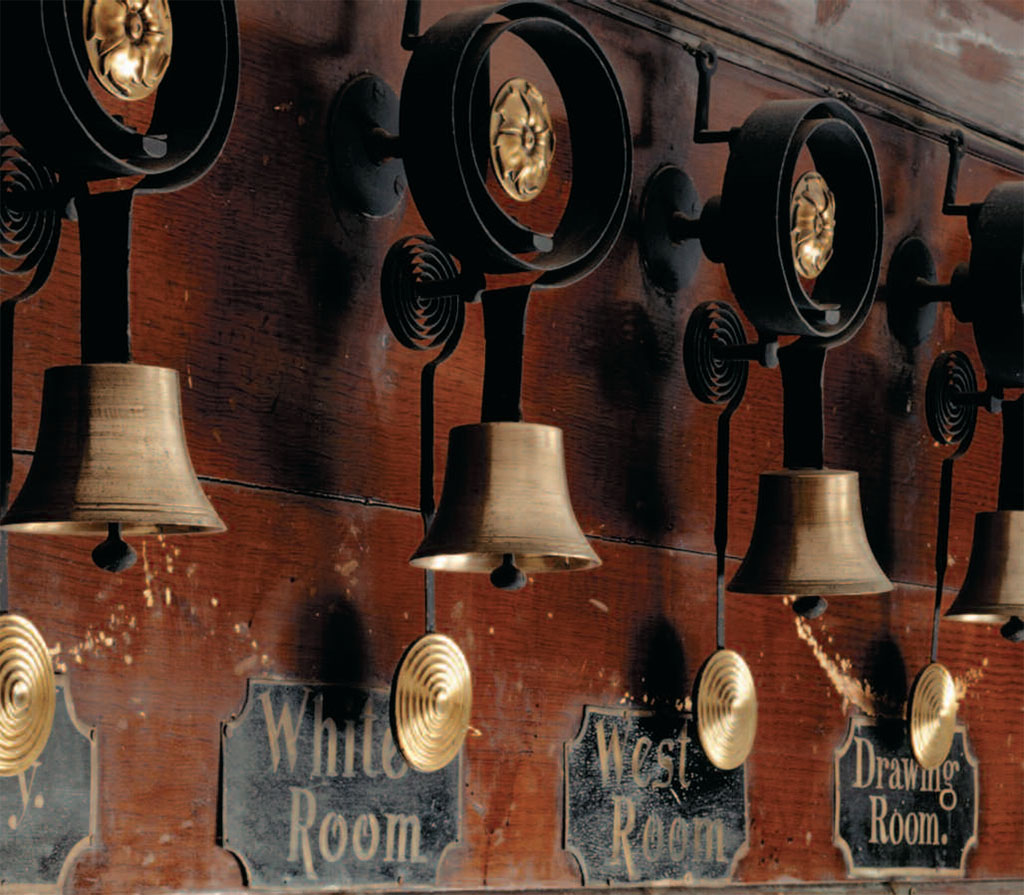
Brass bells on heavy coils mounted in the servants’ hall at Erddig allows servants to see, and hear, when they are summoned to any room in the house. There was no such thing in the servants’ hall as being “off duty.” NTPL/ANDREAS VON EINSIEDEL
Even by the standards of the 19th century, these wages were low. On the other hand, servants had fewer expenses than other workers because accommodation and food were provided. In less affluent houses, this could mean slim pickings, but in the great aristocratic mansions, servants were well fed. They might even sample treats such as games or ice cream leftover from entertainment. When employers were away, servants got board wages: money to buy their own food. The lower servants got less than the senior staff, but nonetheless, even the poorest paid maids could save a little out of it.
But while the hierarchical nature of servants’ work could bear heavily on the lowliest, it gave them a career path. The Marquess of Bath explained, “In the old days when people were brought up to domestic service they moved up from being lamp boys or pantry boys to footmen, groom of chambers or house stewards.” Similarly, a 12-year-old scullery maid on £5 a year in the 1860s could hope to eventually become a cook earning as much as £60.
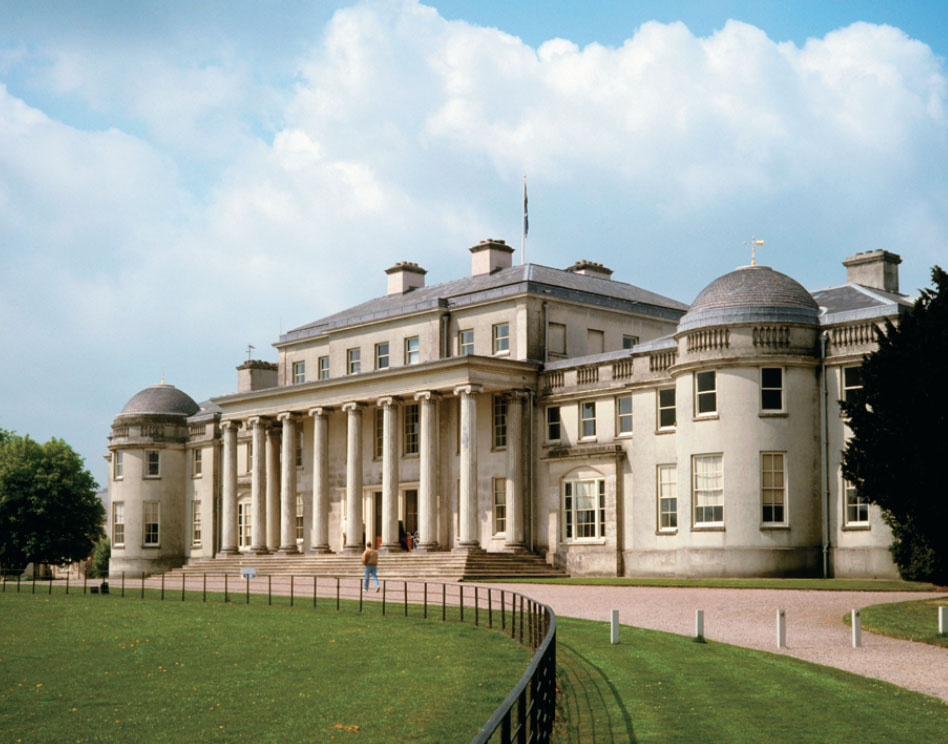
Shugborough House, Stafford, is the seat of the Earl of Lichfield. ARCHITECTURE UK/ALAMY
This is one reason why many servants remained in the same house for most or all of their working lives. Nowhere can this be better seen than at Erddig Hall, the Yorke family home near Wrexham in Flintshire. Here the kitchen and basement walls are covered with oil portraits of the servants, along with poems written about them by the owners of the house. Philip Yorke composed the first tribute—to his cook Mary Rice—in 1786. “Her pies are excellent and good” runs one line. Of kitchen man, Jack Nicholas, he wrote:
Then in the kitchen corner stuck, He pluck’d the fowl and drew the duck, Or with the basket on his knees, Was sheller-general of the peas.
Philip’s son Simon continued the tradition, noting of Thomas Pritchard, a gardener who helped the gamekeeper:
Of cock and partridge rang the knell, And loudly called as dead as hell.
When the Yorke family handed Erddig to the National Trust in 1973, everything in the house remained unchanged, so visitors can see many details of servant life. The Servants’ Hall still has its big table, and also the rows of bells that would have summoned a footman to add coal to the fire, or a parlor maid to bring tea. The Butler’s Pantry has the papier-mâché bowl reserved for washing glasses, a knife grinder and a wine basket for carrying wine from the cellar. To protect its contents, one of the footmen slept nearby, while the maids’ bedrooms can be seen in the attics along with the sitting room where they could sew.
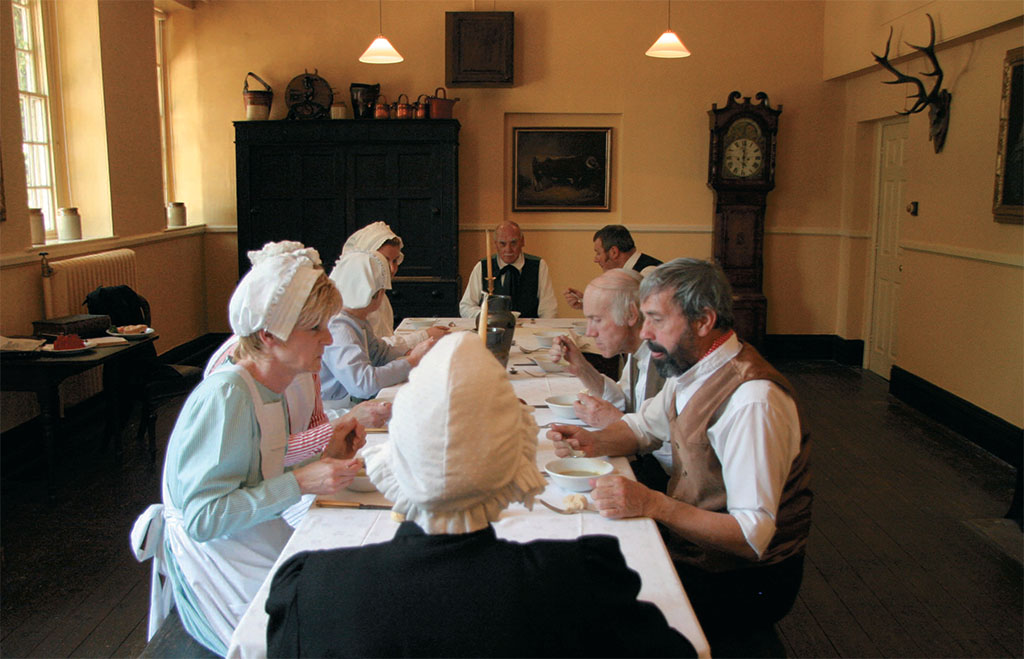
Early afternoon dinner in the servants’ hall was presided over by the butler and the housekeeper. Even below stairs there was a strict social hierarchy in which everyone knew and kept their place. COURTESY OF THE SHUGBOROUGH ESTATE: CHRIS BEECH
Tatton Hall near Knutsford—the Cheshire town that Elizabeth Gaskell fictionalized as Cranford—also has servants’ quarters on display. Here the contrast between the magnificence of the Egerton family’s accommodation, and the basement where the servants spent their days, is especially clear. Turn one way from the entrance, and your path leads through the Music Room, Drawing Room and into the Dining Room where the table is beautifully set with Minton china. Upstairs are 24 bedrooms, including one that has a charcoal-heated tin bath that the housemaids filled with the brass water cans now tucked under the washstand. Turn the other way at the entrance and steps take you to the basement, the scullery and kitchen with its dozens of copper pans and molds, and the Housekeeper’s Sitting Room. There the housekeeper not only managed the servants but also entertained her peers and kept guard over the closets housing the finest china and best linen.
At Shugborough Hall near Stafford, docents trained to play the roles of servants in the Victorian era explain details of their lives. Visitors enter the kitchen garden, where “gardeners” talk about providing vegetables and herbs for the family. Wednesday is Meet the Gardener day when visitors gather outside the Servants’ Quarters for a guided stroll through the grounds. Indoors, a cook gives demonstrations of cooking in an open range in the 1880s kitchen and also provides recipes and answers to questions about 19th-century cooking techniques. Next door to the kitchen, the brewery illustrates the old tradition of homebrewing and usually offers samples of its beer.
Visitors to kitchens and servants' quarters can only be amazed at how hard the servants had to work to keep the great stately homes running. Not least of their difficulties was lack of time off. World War I opened up more jobs, especially for women, and as the 20th century progressed, fewer people would tolerate the restrictions of a servant’s life. Though the Marquess of Bath said he would love to go back to those pampered days at Longleat “because it was so much more comfortable for us,” he did not repine. “I am not complaining,” he said, “times have changed.”
* Originally published in July 2016.





Comments